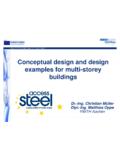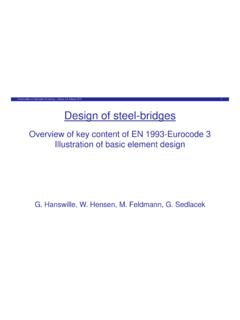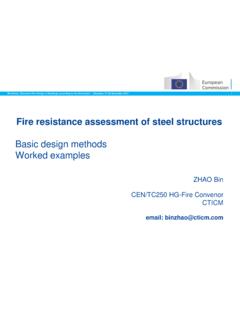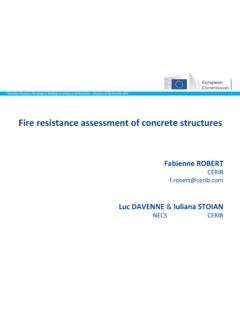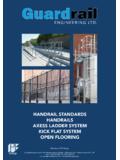Transcription of Eurocode 1: Actions on Structures Part 1-1: General ...
1 Eurocode 1: Actions on Structures Part 1-1: General Actions - Densities, self-weight, imposed loads for buildingsDr-Ing. Nikolaos E. MalakatasHead of Department - Ministry of Environment, Planning and Public Works - GREECEC hairman of CEN/TC250/SC1 Use of EN 1991-1-1 Gives design guidance and Actions for the structural design of buildings and civil engineering works, including the following aspects :- densities of construction materials and stored materials- self-weight of construction elements, and- imposed loads for buildings Is intended for Clients, Designers, Contractors and Public Authorities Is intended to be used with EN 1990 (Basis of Structural Design), other parts of EN 1991 ( Actions ) and EN 1992 to EN 1999 (Materials Eurocodes)
2 For the design of BETWEEN THE EUROCODESEN 1990EN 1991EN 1992EN 1993 EN 1994EN 1995 EN 1996 EN 1999EN 1998EN 1997 Actions on structuresDesign and detailingGeotechnical and Seismic designStructural safety, serviceability and durabilityProgramme of implementation of EN 1991-1-1 Received positive vote as EN in April 2002 (Supersedes ENV 1991-2-1 : 1995) Published by CEN in July 2002 Confirmed in 2007 for a further period of 5 years Implementation on a national level in the Member States (National Standard EN 1991-1-1 and National Annex) still in process Withdrawal of conflicting standards probably by 2009/2010 Contents of EN 1991-1-1 Foreword Section 1 General Section 2 Classification of Actions Section 3 Design Situations Section 4 Densities of Construction and Stored Materials Section 5 Self-weight of Construction Works Section 6 Imposed Loads on Buildings Annex A (Informative)
3 Tables for Nominal Density of Construction Materials, and Nominal Density and Angles of Repose for StoredMaterials Annex B (Informative)Vehicle Barriers and Parapets for Car ParksScope of EN 1991-1-1 Design guidance and Actions for the structural design of buildings and civil engineering works, including:- densities of construction materials, additional materials for bridges and stored materials (Section 4 & Annex A),- self-weight of construction elements (Section 5), and -imposed loads for building floors and roofs (Section 6), according to category of use :- residential, social, commercial and administration areas;- garage and vehicle traffic areas (for gross vehicle weight < 160 kN);- areas for storage and industrial activity;-roofs;- helicopter landing areas.
4 Actions on silos and tanks caused by water or other materials are dealt in EN 1991-4 Snow load on roofs is dealt in EN 1991-1-3 Classification of Actions (Reminder from EN 1990) Variation in time: Permanent, VariableorAccidental Origin: Director Indirect Spatial Variation: FixedorFree Nature and/or structural response: Static orDynamicClassification of Actions (cont.) Self-weight of construction works: generally a Permanent Fixedaction, however If Variable with timethen represented by upper and lower characteristic values, and If Free( moveable partitions) then treated as an additional imposed load.
5 Ballast and earth loads on roofs/terraces: Permanentwith variations in properties (moisture content, depth) during the design life being taken into of Actions (cont.) Imposed loads (on buildings): generally Variable Freeactions, however loads resulting from impacts on buildings due to vehicles or accidental loads should be determined from EN 1991-1-7. Imposed loads for bridges are given in EN 1991-2. Also : Imposed loads generally Quasi-staticactions and allow for limited dynamic effects in static Structures , if there is no risk of resonance. Actions causing significant acceleration of structural members are classified as Dynamicand need to be considered via a dynamic analysis However for fork-lift trucksand helicoptersadditional inertial loads from hoisting and take-off/landing are accounted for through a dynamic magnification factor applied to appropriate staticload valuesDesign situations Permanent loads The total self-weight of structural and non-structural members is taken as a single actionwhen combinations of actionsare being considered Where it is intended to add or remove structural or non-structural members
6 After construction critical load cases need to be identified and taken into account. Water level is taken into account for relevant design situations, as is the source and moisture content of materials in buildings used for storage situations Imposed loads Where areas are likely to be subjected to different categories of loadings, the critical load case needs to be identified and considered When imposed loadsact simultaneously with other variable Actions ( wind, snow, cranes or machinery) the total of those imposed loads may be considered as a single action. However, for roofs of buildings, imposed loads should not be considered to act simultaneously with snow loads or wind aspects Self-weight may be usually determined as a product of the volume and the density, which both as random variables that may be described by normal distributions, with a mean value very close to their nominal value.
7 Imposed loads are usually described by a Gumbeldistribution, although Gamma distributions may also be used for the sustained (long-term) loads and exponential distributions for the intermittent (short-term) of construction and stored materials Characteristic valuesof densities of construction and stored materials should generally be used. (If there is a significant scatter - due to their source, water content etc. an upper and a lower value should be used). Where only mean values are available, they should be taken as characteristicvalues in the design. Mean values for a large number of different materials are given in EN 1991-1-1 Annex A.
8 For materials not in Annex A either:- the characteristic value of density needs to be determined in the National Annex,- a reliable direct assessment is carried out (eventually according to EN 1990 Annex D).Self-weight of construction works Generally represented by a single characteristic valuecalculated from nominal dimensions, characteristic values of densities and including, where appropriate, ancillary elements, non-structural elements and fixed services, weight of earth and ballast. Non-structural elements include :- roofing;- surfacing and coverings;- partitions and linings;- hand rails, safety barriers, parapets and curbs;- wall cladding;- suspended ceilings;- thermal insulation;- fixed servicesSelf-weight of construction works (cont.)
9 Fixed services include :- equipments for lifts and moving stairways;- heating, ventilating and air conditioning equipment;- electrical equipment;- pipes without their contents;- cable trunking and conduits Loads due to movable partitions are treated as imposed loads, but an equivalent uniformly distributed load may be of construction works (cont.)Additional provisions specific for bridges: For ballast on railway bridges or fill above buried Structures the upper and lower characteristic values of densities should be taken into account. The upper and lower characteristic values of the ballast depth should be considered as deviating from the nominal depth by 30%.
10 The upper and lower characteristic values of the thickness due to waterproofing, surfacing and other coatings should be considered as deviating from the nominal value by 20% (if a post-execution coating is included in the nominal value) otherwise +40% and 20%, respectively. The upper and lower characteristic values of the self-weight of cables, pipes and service ducts should be considered as deviating from the mean value by 20% .Imposed loads on buildings Characteristic valuesof imposed loads for floors and roofs for the following types of occupancy and use:- residential, social, commercial and administration areas- garage and vehicle traffic- areas for storage and industrial activities-roofs- helicopter landing areas- barriers and walls having the function of of Actions Imposed loads on buildings are those arising from occupancy and the values given include :- normal use by persons; - furniture and moveable objects;- vehicles.


